Abstract
The cultivation of leafy vegetables in Japanese agriculture is attracting attention in terms of yield, cultivated area, and shipping volume. According to data for 2022, the national harvest was 39kt, with the largest cultivated area being 2.32kha, and the shipping volume being 17.5kt in Ibaraki. Based on past trends, production of leafy vegetables has remained relatively stable, while Ibaraki has the largest shipping volume. Furthermore, there is a correlation between cultivated area and harvest volume, suggesting that production is being adjusted to meet demand. Under these circumstances, Japanese agriculture has maintained the production and distribution of leafy vegetables while adapting to technological innovation and changes in market demand.
Mizuna harvest volume (main data).
Looking at data from 2010 to 2022, we can see that the yield of Mizuna in Japanese agriculture has fluctuated. At its peak in 2019, a harvest of 44.4kt was recorded nationwide, which is the maximum. However, yields have declined somewhat in subsequent years, with the current yield reported in 2022 being 87.8% of the peak. This trend suggests that the yield of Mizuna varies from year to year. In addition, the rate of decline from the peak has been relatively gradual, suggesting that the demand for and cultivation conditions of Mizuna are relatively stable. This suggests that Mizuna cultivation meets a certain demand in Japanese agriculture and that stable production continues.
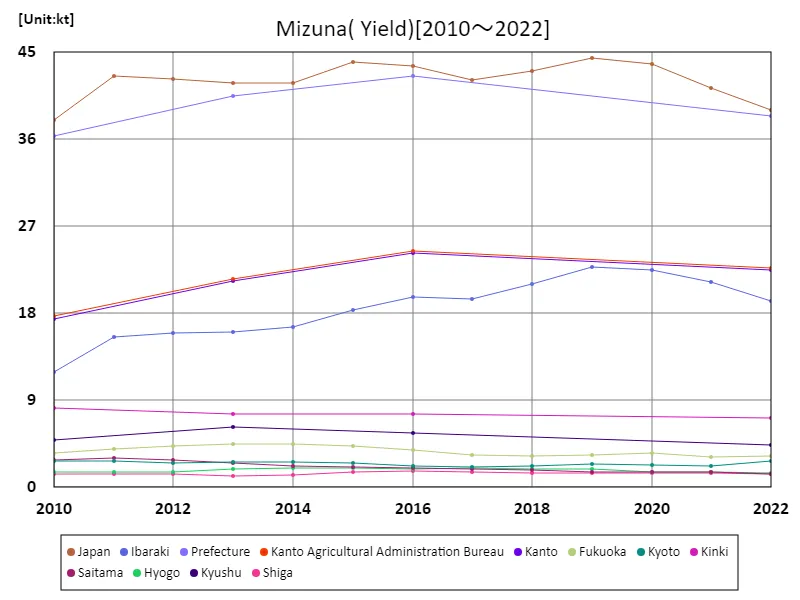

The maximum is 44.4kt[2019] of Japan, and the current value is about 87.8%
Mizuna harvest volume (by prefecture).
According to the latest data for 2022, Ibaraki recorded the highest leafy vegetable harvest in Japan at 19.3kt, which is currently the highest. This data shows that Ibaraki is a leader in leafy vegetable production. Also, looking at past trends, some regions, including Ibaraki, are actively engaged in leafy vegetable production and may be increasing production to meet demand. Furthermore, since Ibaraki has the highest overall production, it is possible that other prefectures are also focusing on producing leafy vegetables, but Ibaraki’s production volume is particularly noteworthy. This situation suggests that there is active competition between regions in the production of leafy vegetables in Japanese agriculture, and that efficient production is carried out in line with demand.
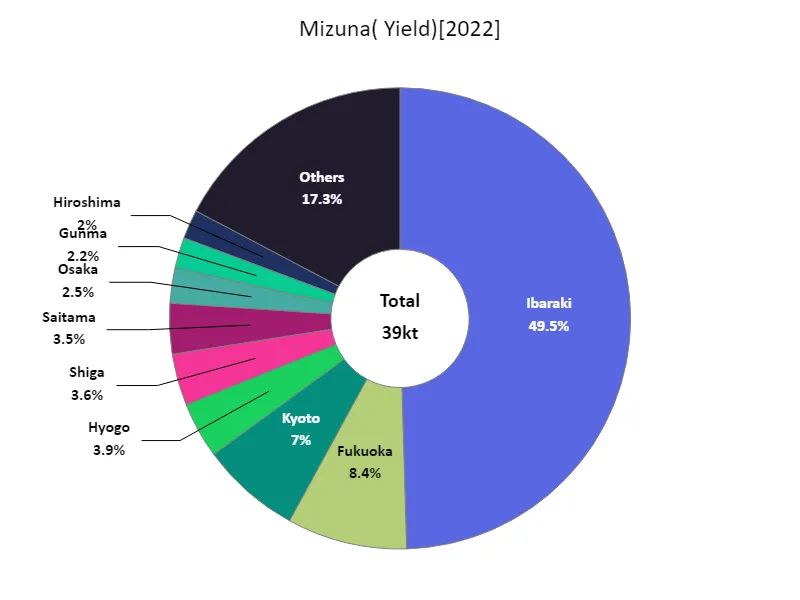

The maximum is 19.3kt of Ibaraki, the average is 829t, and the total is 39kt
Mizuna cultivation area (main data).
Looking at data from 2010 to 2022, the area of land planted with Mizuna in Japanese agriculture has fluctuated. The maximum was recorded in 2015 at 2.55kha nationwide, which has declined slightly since then, with the current crop area reported in 2022 being 91% of the peak. This trend indicates that the area cultivated with Mizuna has decreased slightly since its peak. In addition, the rate at which the cultivated area has decreased compared to its peak has been relatively gradual, suggesting that mizuna cultivation is meeting a certain demand. In addition, given the trend of peaking in 2015, it is possible that demand for mizuna and its cultivation was particularly high during this period. From this information, it can be seen that in Japanese agriculture, the area planted with Mizuna is adjusted according to demand, and relatively stable production is being carried out.
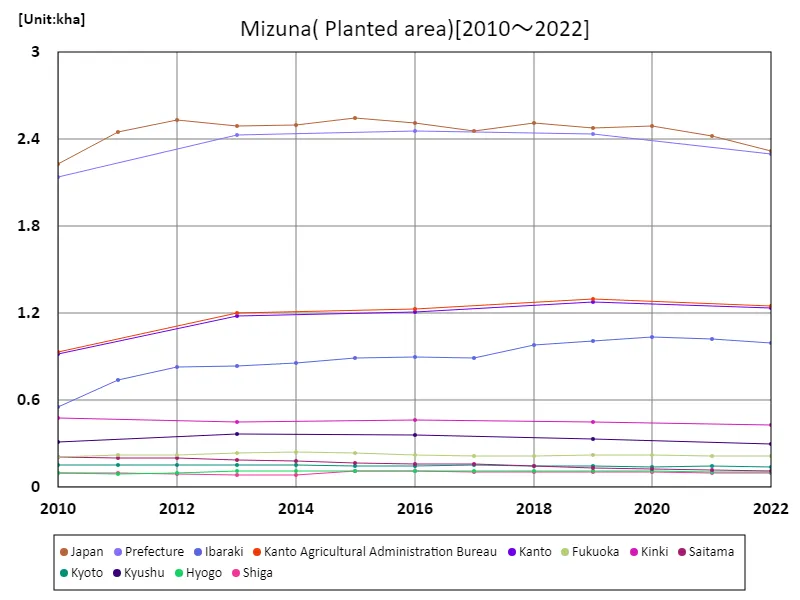

The maximum is 2.55kha[2015] of Japan, and the current value is about 91%
Mizuna cultivation area (by prefecture).
According to the latest data from 2022, Ibaraki has the largest area of land planted to leafy vegetables in Japanese agriculture in the country at 996 hectares, which is currently the largest value. This data shows that Ibaraki is a leader in leafy vegetable cultivation. Also, looking at past trends, it appears that some regions, including Ibaraki, are actively engaged in cultivating leafy vegetables. Furthermore, since Ibaraki has the highest overall area, it is possible that other prefectures are also focusing on cultivating leafy stem vegetables, but Ibaraki’s cultivated area stands out. This situation suggests that there is active competition between regions in the cultivation of leafy vegetables in Japanese agriculture, and that efficient cultivation is carried out in line with demand.
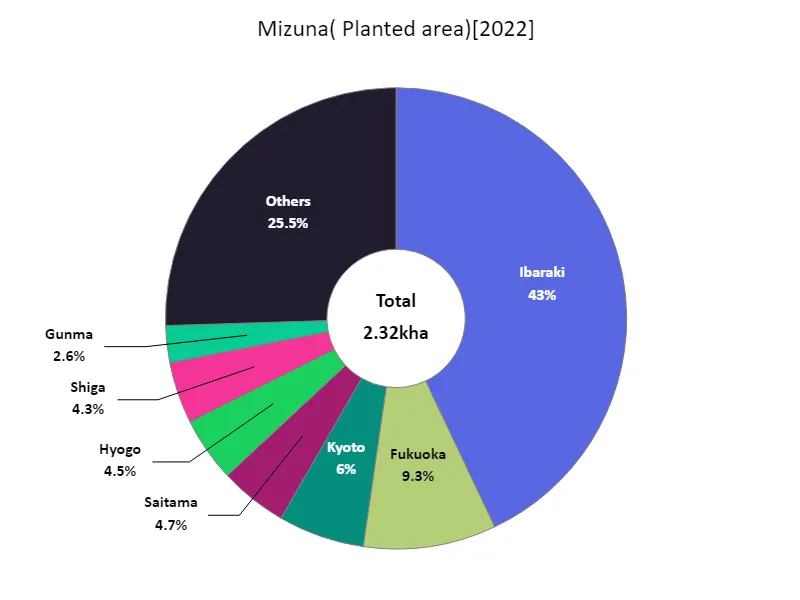

The maximum is 996ha of Ibaraki, the average is 49.3ha, and the total is 2.32kha
Mizuna shipping volume.
The overall shipment volume of leafy vegetables in Japan in 2022 is reported to be the highest in Ibaraki at 17.5kt, with an average of 742t and a total of 34.9kt. This data shows that Ibaraki stands out in terms of the volume of leafy vegetable shipments. In addition, the average shipping volume was 742 tons, which indicates that shipping of leafy vegetables is relatively uniform across the country. Furthermore, the total shipment volume of 34.9kt suggests that there is a certain amount of demand for leafy vegetables across Japan. Past trends indicate that Ibaraki is a major producer of leafy vegetables, with other regions also actively shipping them. Under these circumstances, Japanese agriculture is producing and shipping leafy vegetables to meet demand, with several regions, including Ibaraki, assuming market leadership roles.
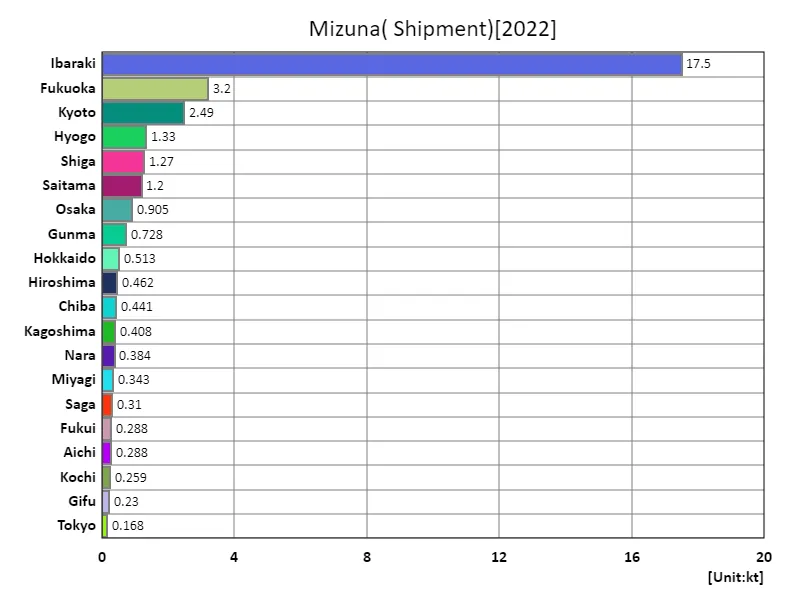

The maximum is 17.5kt of Ibaraki, the average is 742t, and the total is 34.9kt
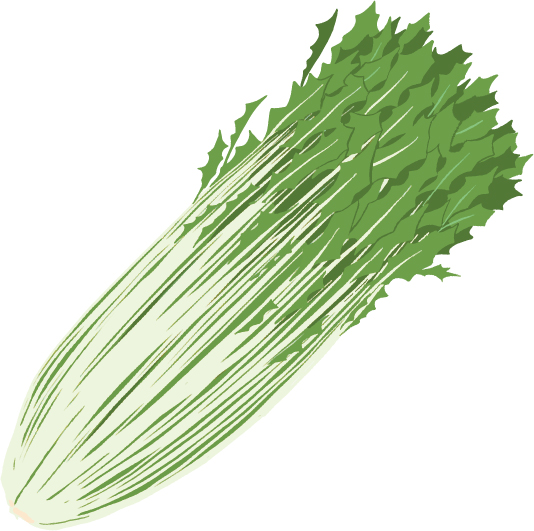


Comments